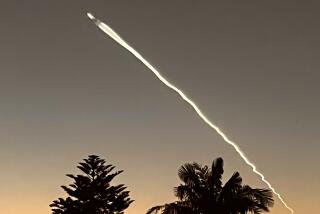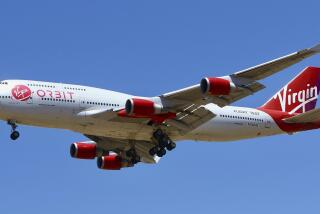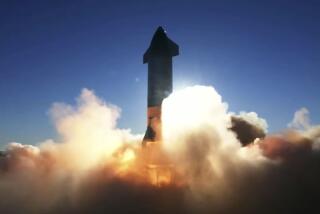Douglas Wins Contract for Rocket System
The U.S. Air Force Space Division has awarded McDonnell Douglas Corp. a $169.4-million contract for 28 rockets designed to launch a new series of defense satellites from the space shuttle, the Air Force said Tuesday.
The contract signals the government’s apparent confidence in the rocket system, which just a year ago publicly embarrassed McDonnell Douglas by twice failing to send commercial satellites into their proper orbits after a space shuttle launch.
The Air Force contract represents the St. Louis-based company’s first sale of the rocket system to the federal government. Earlier sales of the system, which has been under development since 1976, were made to commercial customers, such as Western Union, whose communications satellite was one of two sent into improper orbits last year.
The award should also provide an important economic and morale boost for McDonnell Douglas’ astronautics unit in Huntington Beach, which has been seeking replacements for rocket and ballistic contracts that are winding down or being thrown open to new bidding.
No New Hiring Seen
Despite the importance of the latest contract, company officials said it will not result in an immediate hiring increase at the 5,200-worker Huntington Beach facility, where the rockets are to be assembled. About 400 employees are assigned to the Payload Assist Modules program, as the rocket systems are called.
Since the well-publicized failures last February, McDonnell Douglas officials say that they have improved the rocket system with a new motor design. The second-generation system, which the Air Force is buying, is dubbed PAM-DII.
The rockets will be used to launch Navstar Global Positional System satellites, a series of navigation satellites to be used primarily by the Department of Defense and other members of the North Atlantic Treaty Organization.
The first delivery in the five-year contract is scheduled for later this year. The first navigation satellite launch using the PAM-DII rocket has been set for 1986 from the Kennedy Space Center in Florida.
Although primarily a military system, the Navstar system will also be available for civilian use. Potential worldwide civilian users include commercial shipping, air traffic and search and rescue parties. A second, coded channel will provide data to military users.
More to Read
Inside the business of entertainment
The Wide Shot brings you news, analysis and insights on everything from streaming wars to production — and what it all means for the future.
You may occasionally receive promotional content from the Los Angeles Times.










